
By Key Jo Lee, associate curator of American art
Some of the reasons why curators place certain objects in certain places in the galleries are very apparent. This is by design. Typically, the goal is for each artwork to tell some part of a larger story that illuminates a time period, an artistic style, a theme, a person, and at times a blend of them all. The challenge is that we must convey that information within the well-informed parameters set by the Cleveland Museum of Art’s department of interpretation, which sets the museum’s standards for length and accessible content and language, among other important endeavors. As a curator, it is my job to provide factual and interesting information that has the potential to engage every visitor. This is no short order! Were we to place every line of research on the walls of the gallery, there would be no room for the art. So, you might wonder how curators and interpretation specialists synthesize large amounts of information into the short texts you see in the gallery. To give readers a peek behind the curtain, I’m going to fill you in on some of the historical background that informed the text panel “Art and Allegory” that accompanies one of the CMA’s new acquisitions, Why Born Enslaved! by Jean-Baptiste Carpeaux.
Created three-quarters of a century after the onset of the French Revolution (1789) and 20 years after France’s final abolition of slavery in 1848, Jean-Baptiste Carpeaux’s exquisitely devastating bust, entitled Porquoi naître esclave? or Why Born Enslaved!, was one of the most critically acclaimed and popular images produced by the artist — perhaps the most popular of his career, gaining him both fame and fortune. But why was this image of an unnamed Black woman so favored by a nearly exclusively white audience years after slavery had been, supposedly, eradicated? Its placement in the galleries of the Cleveland Museum of Art offers a few clues.
The arrival of Why Born Enslaved! at the CMA has been met with well-deserved enthusiasm. As senior curator of modern art William Robinson expressed, “It’s breathtaking. As you walk around it, it reveals a series of very aggressively dynamic forms [that are] almost explosive. And the expression on her face is extraordinary.” Carpeaux’s technical skill is exemplified in his naturalistic rendering of the sitter; her facial expression pulsates with emotion, at once abject and defiant, mournful and contentious, ever-changing and dependent upon where one stands in relation to the sculpture (figs. 1–6).
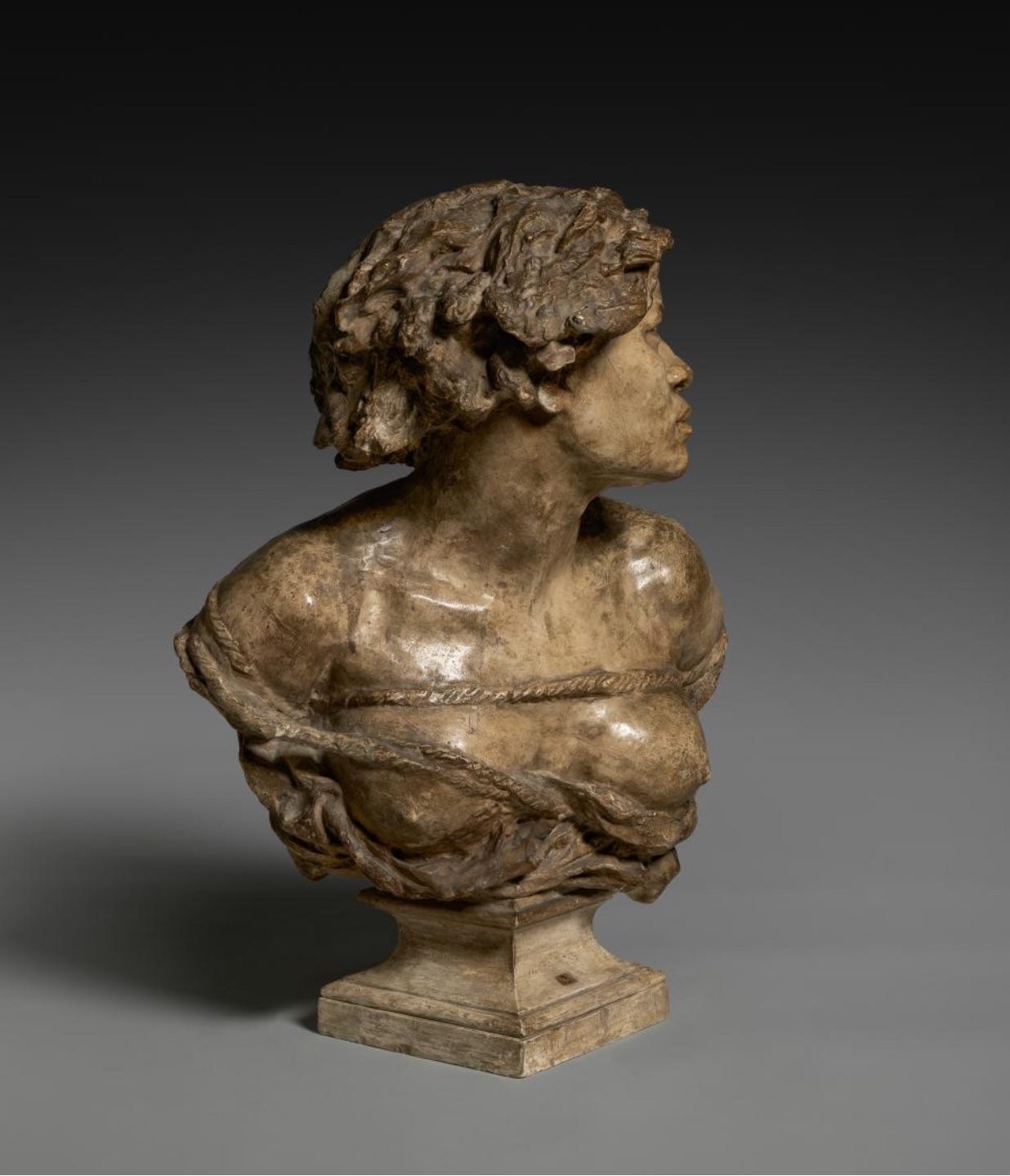
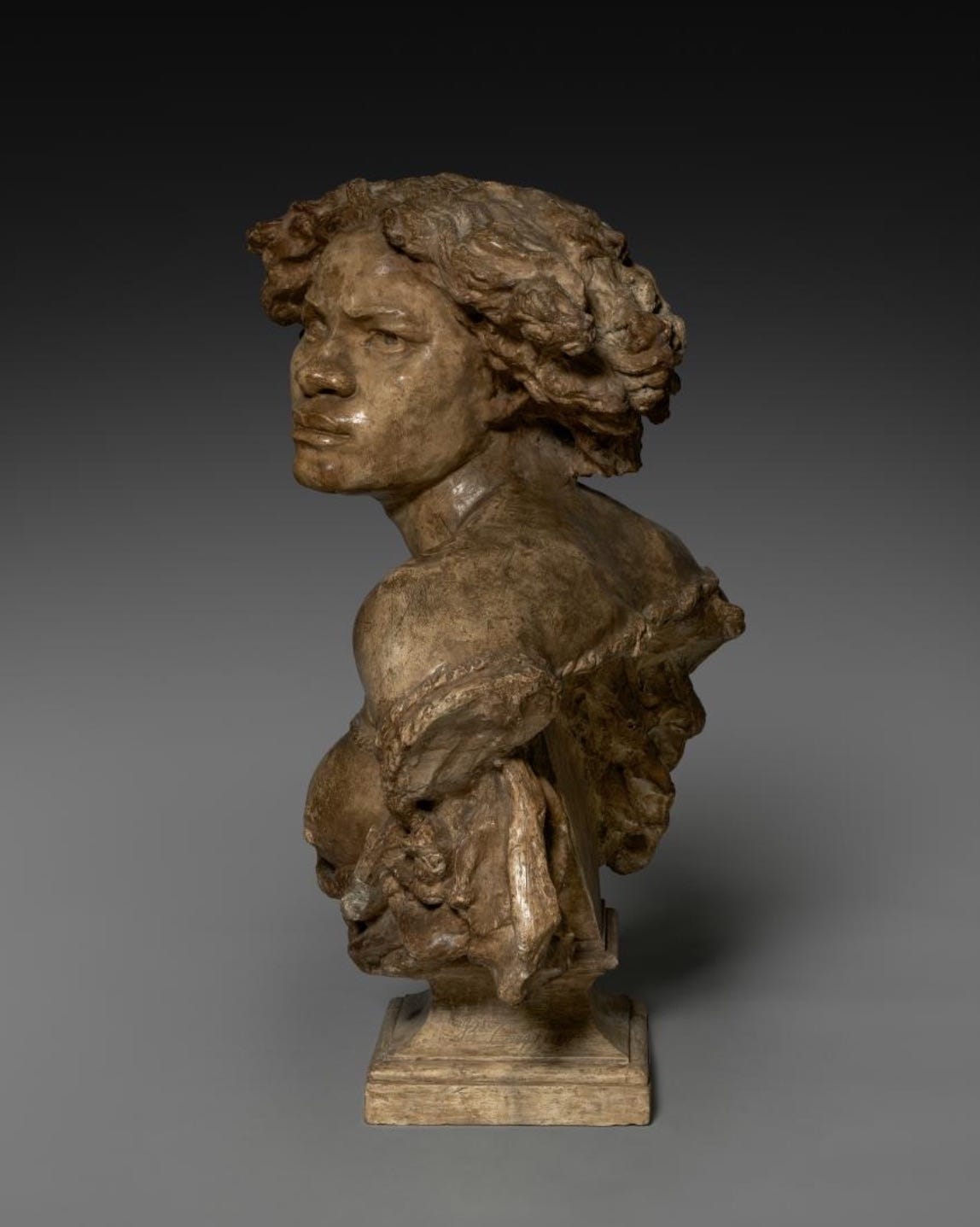
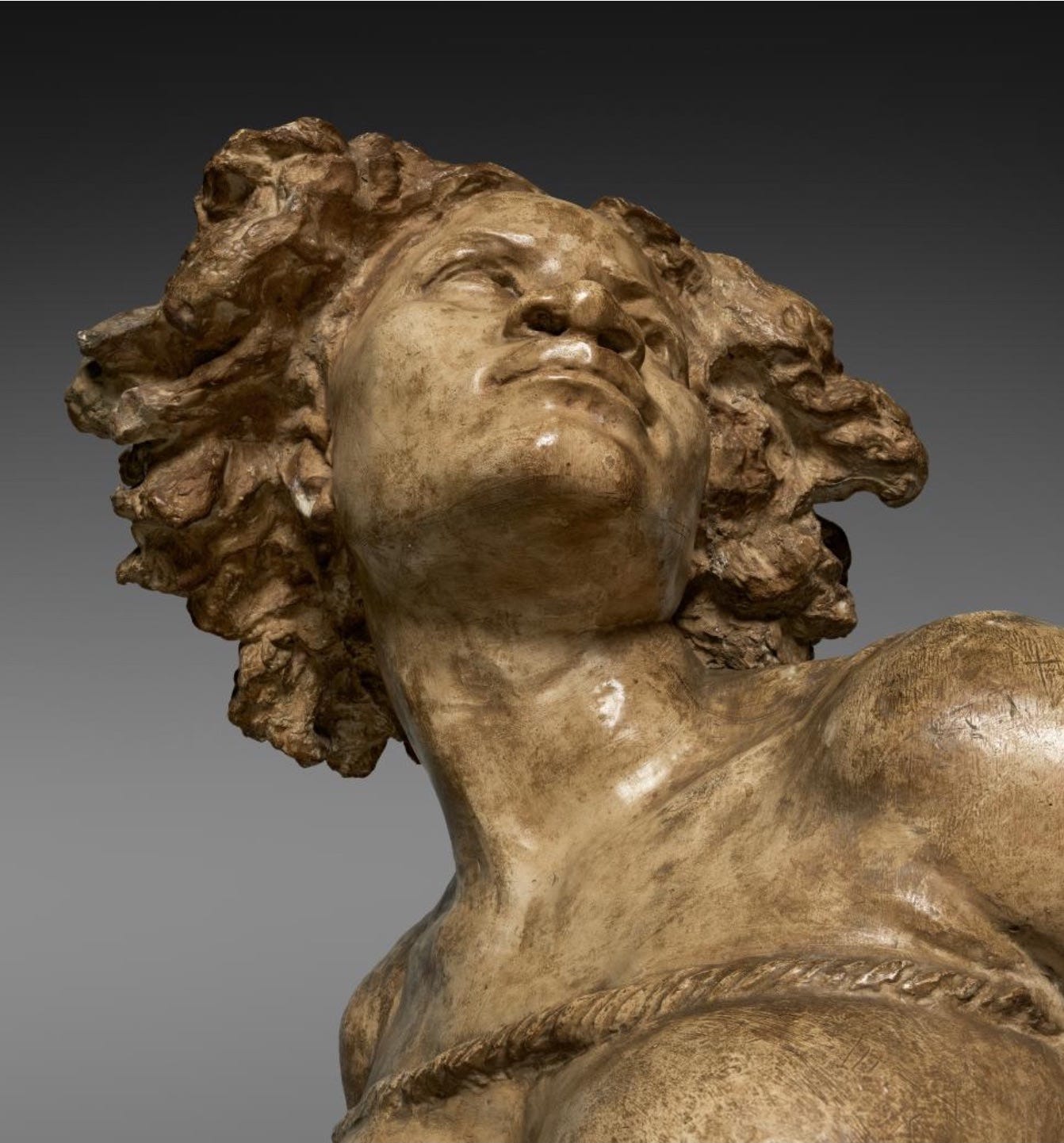
However, it is the context created by its placement that points toward an answer for the sculpture’s popularity at the time of its making.
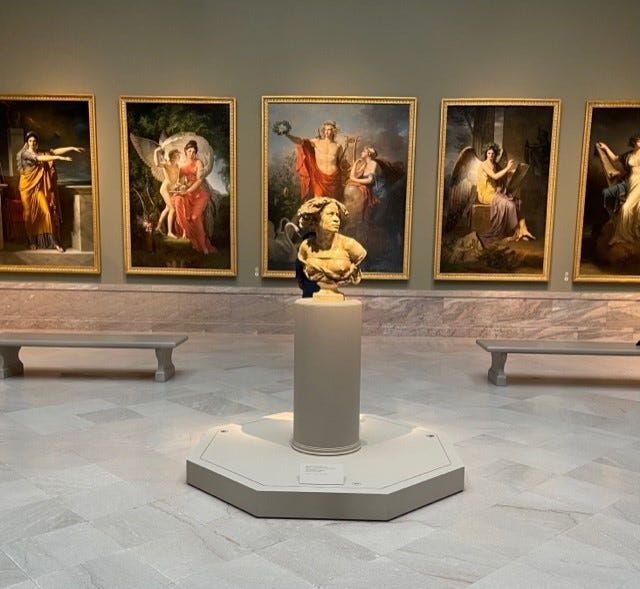
The bust is installed at the center of gallery 201 (fig. 7) amid Charles Meynier’s French neoclassical depictions of mythical embodiments of eloquence, lyrical poetry, epic poetry, and astronomy, or the muses, made just as the budding French republic was ushering in the Napoleonic age and reflecting the artistic conservatism in vogue among the elite at the time. Very different from the contorted position and emphatic countenance of Why Born Enslaved!, Meynier’s faces and body positions hark back to classical forms of otherworldly figures, meant to draw comparisons between the ancient Greek republic and the new French republic at a pivotal moment after the abolition of feudal rights and the establishment of the Declaration of the Rights of Man and of the Citizen, the 15 articles of which begin:
The representatives of the French people, organized as a National Assembly, believing that the ignorance, neglect, or contempt of the rights of man are the sole cause of public calamities and of the corruption of governments, have determined to set forth in a solemn declaration the natural, unalienable, and sacred rights of man, in order that this declaration, being constantly before all the members of the Social body, shall remind them continually of their rights and duties; in order that the acts of the legislative power, as well as those of the executive power, may be compared at any moment with the objects and purposes of all political institutions and may thus be more respected, and, lastly, in order that the grievances of the citizens, based hereafter upon simple and incontestable principles, shall tend to the maintenance of the constitution and redound to the happiness of all.[1]
Though women were implied but not named in the declaration, Meynier’s allegorical depictions of women nevertheless form a visual synthesis between two eras and their greatness. And, as a setting for Why Born Enslaved!, Meynier’s portraits of the muses and of the god Apollo, with their marblelike whiteness, call even greater attention to the bust by its contrast. This juxtaposition drives the question found in the object’s wall text: What is the difference between Carpeaux’s personification of enslavement and Charles Meynier’s personifications of the muses?
While traditional characterizations exist of Carpeaux’s depiction of an enslaved woman as an exclamation of the artist’s personal abolitionist sentiment, the artwork’s success cannot be separated from the simultaneous contemporary penchant for “exotics” in French art and society. This is a confluence of particular note to the curators of the exhibition Fictions of Emancipation: Carpeaux Recast, currently on view at the Metropolitan Museum of Art, who highlight the ways in which “the truth of the work’s creation and the context from which it was borne is more complex. Carpeaux was in dire financial straits when he produced the work, which was reproduced many times over by his workshop before his death in 1875 at 48, and so Why Born Enslaved! was for him one way of capitalizing on a fervor for abolitionist imagery in France, where he was based.”[2] Like Meynier’s adoption of classical forms to convey a connection between the past and the present to elevate a particular vision of France, so too does Carpeaux tap into the contemporary taste in his choice of subject.
As one reviewer of the exhibition at the Met describes, “while Carpeaux may have grown famous for works such as this one, with its finely wrought psychology and its skillful rendering of tensile flesh, the identity of the model for Why Born Enslaved! remains unknown. All of which is not to mention the work’s similarities to ethnographical sculptures, which were used throughout the West for centuries as a racist tool to assert the dominance of whites over the various peoples they colonized.”[3] It is clear that Carpeaux was influenced by works like Liberty Leading the People of 1830 (fig. 8), Eugène Delacroix’s famous allegorical depiction of Liberty as a pale, bare-breasted, and powerful goddess leading revolutionaries toward freedom. Notice how she dwarfs those around her as she gestures forward with a finely muscled arm. The drape of her gown and sandaled feet recall Greek statuary, not unlike Meynier’s muses, and she wears a Phrygian cap, an ancient symbol of liberty.

However, Why Born Enslaved! was also produced during a period in which there was a historical and contemporary proliferation of images of Black women that registered a very different meaning and circulated in various forms among every strata of the populace. From fine paintings and sculptures to inexpensive prints, images showing Black women as an exotic other were particularly popular starting at the turn of the 19th century in France. Paintings like Sophie de Tott’s Ourika (c. 1793) and Marie-Guillemine Benoist’s Portrait d’une femme noire, recently renamed Portrait du Madeleine (1800) (figs. 9, 10) were commissioned and owned by wealthy patrons.
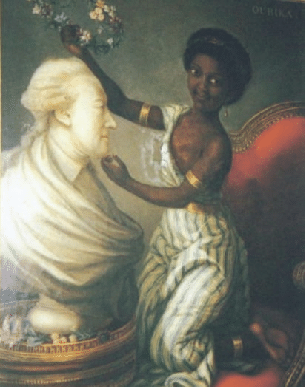
It’s important to note that Tott’s and Benoist’s subjects have the distinction of being named, though it took centuries and deep archival work to reveal the name of Benoist’s model. In both works, one of the model’s breasts is bared and, unlike the strong and triumphant pose of Delacroix’s Liberty, each is in a passive posture. And while their opulent fabrics and adornments might have otherwise suggested personal wealth, it was a convention at the time to depict the enslaved as luxury items richly attired to testify to the wealth of those that held them. As such, the French public would have recognized them as standing for something wholly human rather than as goddess-like beings. Artworks like this make a much stronger comparison to Carpeaux’s sculpture in that the model’s defiance, while speaking to emotional agency, is nevertheless physically bound and very, very human.
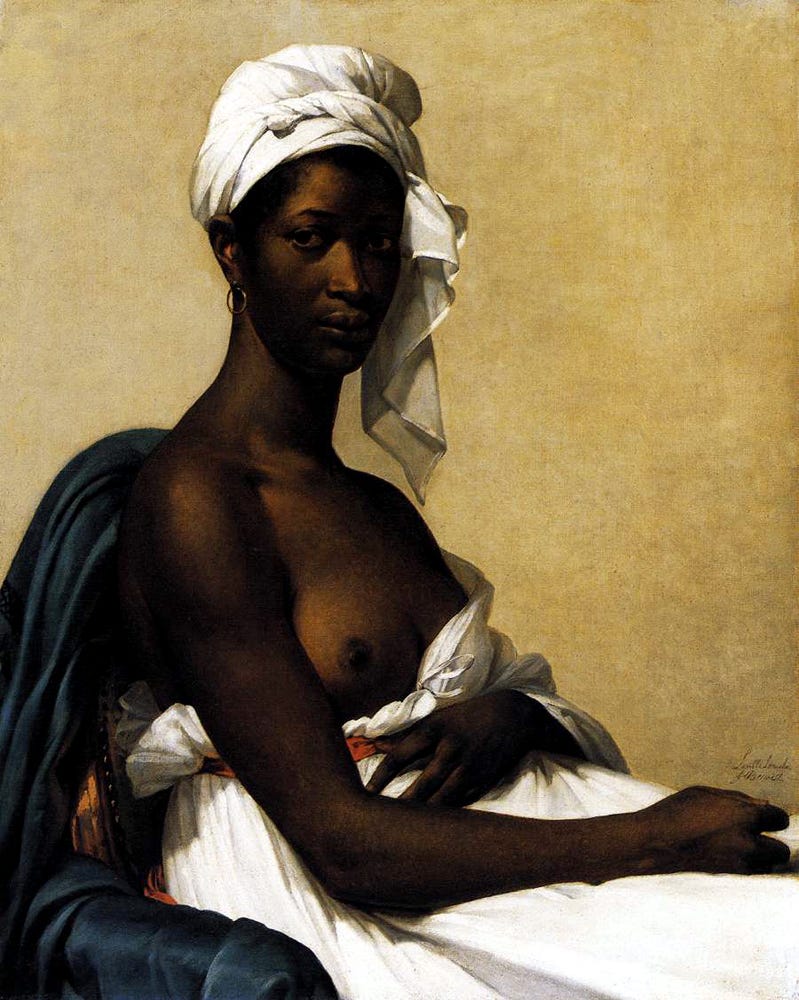
But Carpeaux’s bust would not only have been informed by these fine paintings, but also by popular images like Sebastien Coeure’s watercolor of the so-called Hottentot Venus from 1830 (fig. 11).
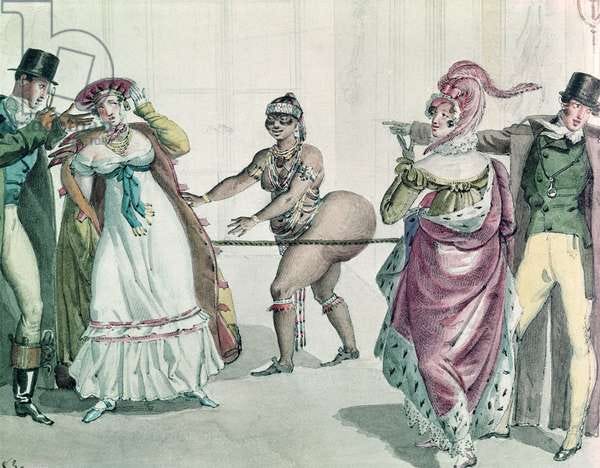
Saartjie (Sarah) Baartman, was born in South Africa, likely in the very late-1780s, and was eventually smuggled to England where “Because she was considered an oddity, her handlers hoped that European fascination with certain types of human curiosities would garner income and fame.”[4] Also called the Hottentot Venus, in reference to her origins and her form, Baartman was indeed popular. One official account recalls how what were considered her remarkable bodily proportions were “dressed in a color as nearly resembling her skin as possible . . . and the spectators are even invited to examine the peculiarities of her form,”[5] as she was “exhibited” live in London and then Paris from the age of ten, around 1799, until she died at the age of 25 or 26 in late 1815 or early 1816. Considered humorous at the time, a combination of fascination, revulsion, desire, and embarrassment characterize Baartman’s viewers as she was shown as a jovial and willing participant in the spectacle. The archive tells a different story. It is said that a contract was broken between Baartman and her “handlers” that would have consigned her to two years of domestic service and display before returning her to South Africa. Instead, she would never see her homeland alive again. Saartjie Baartman changed hands multiple times in her remaining years. After her death, her body was dissected and preserved by the famous naturalist George Cuvier, who placed her brain, skeleton, and genitals on public view where they remained until 1974 in Paris’s Musée de l’Homme. Her remains were ultimately returned to South Africa in 2002 (fig. 12).
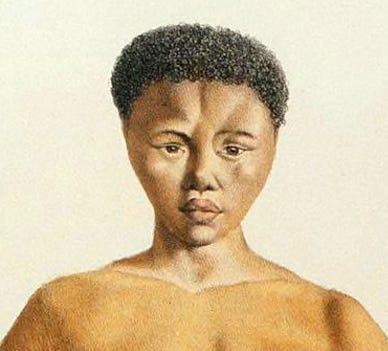
This important lineage is not overt in the display of Why Born Enslaved! Imagine posting this entire essay on the wall! Rather, this visual history is embedded in the two questions that close the panel entitled “Art and Allegory.” It asks: what is the difference between Carpeaux’s personification of enslavement and Charles Meynier’s personification of history, lyrical poetry, or epic poetry in the other works in this gallery? And what are the enduring consequences of transforming a Black individual into a generalized representation of enslavement? In asking these questions, my goal is to invite visitors to explore beyond the wall text by suggesting that there is more to learn. Even this essay by no means expresses all the possible associations to be found among the artworks in gallery 201, and each of the CMA’s curators would probably highlight a different aspect of these connections. And you, dear reader, will always know that there is more than meets the eye in every museum gallery.





